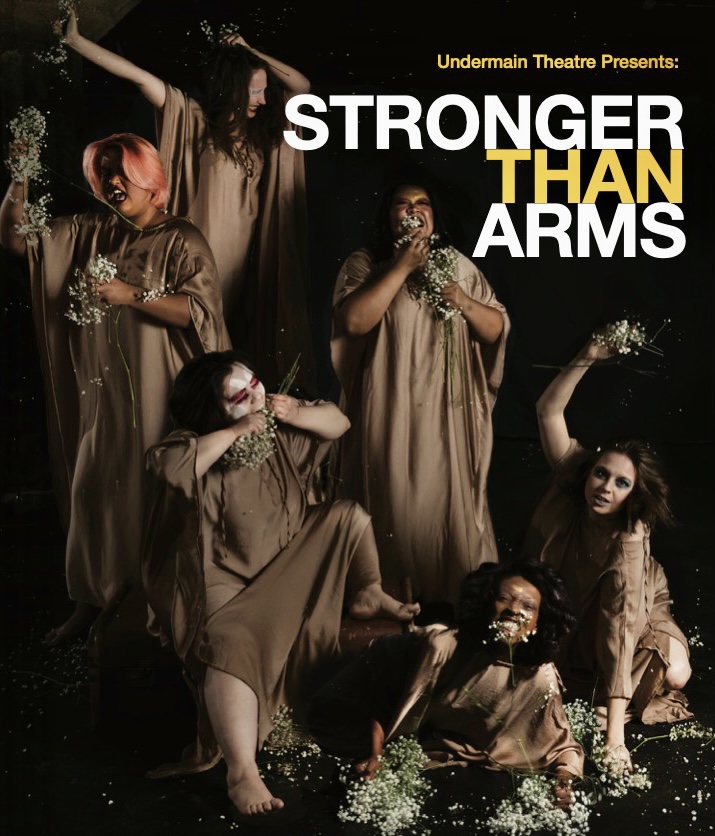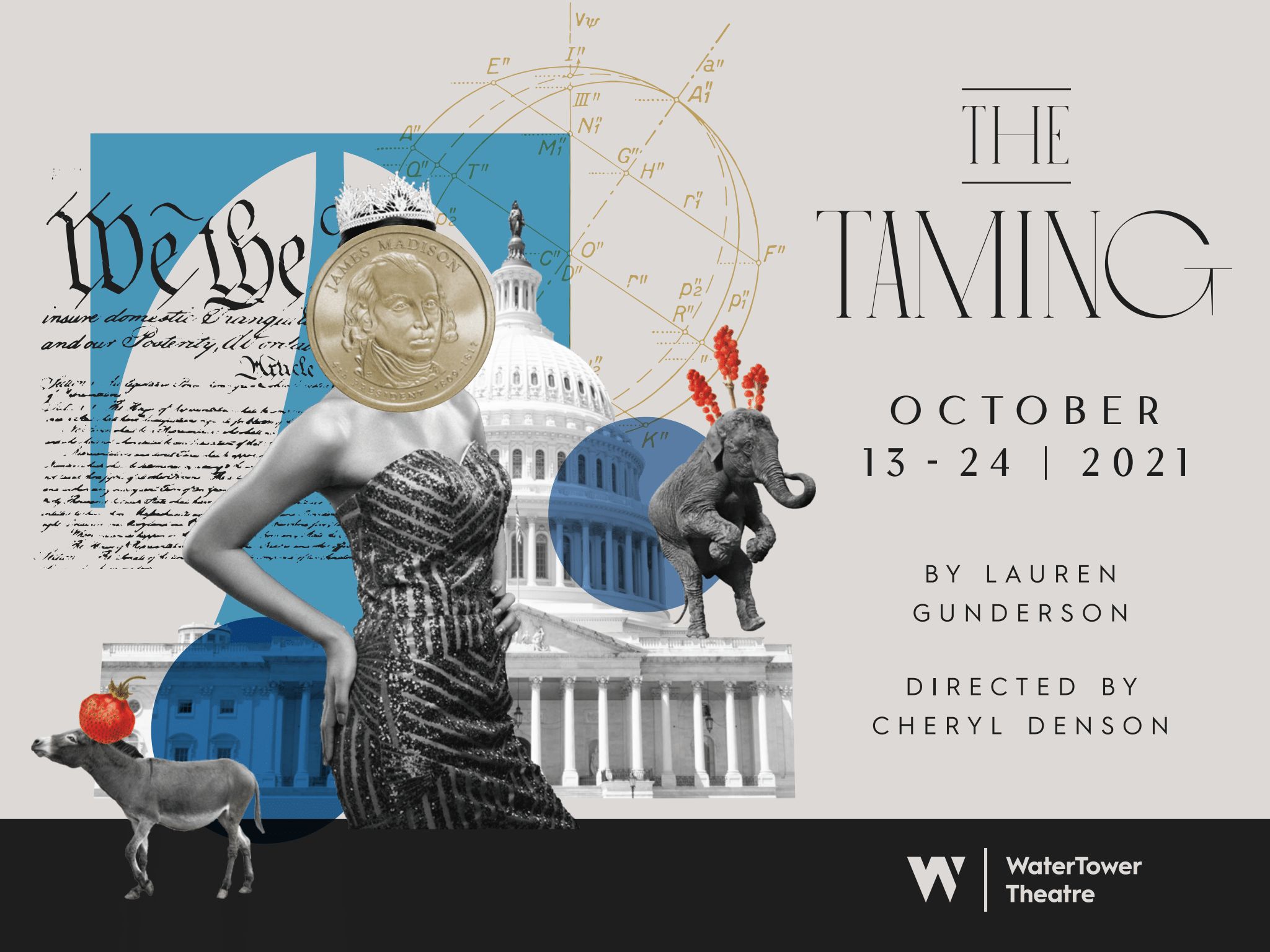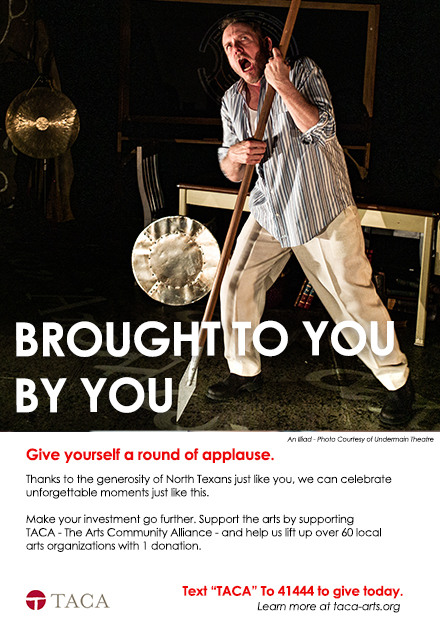
Undermain Theatre and the Danielle Georgiou Dance group are proud to present Stronger Than Arms, a new adaptation of Aeschylus’s Seven Against Thebes done in the inimitable style of DGDG. Writer/director/choreographer Danielle Georgiou and writer Justin Locklear will dive into the spiritual and political burdens placed on the chorus of Theban citizens. As the generational conflicts of territory and birthright ravage the cities around them, the chorus is divided, revealing their individual conflicts and motivations. The title stems from the line, “Fear is stronger than arms,” while the story points to the power of humanity’s worst enemy, unconquerable fear, and reveals that there could be something stronger—the willingness to change. Told through poetic verse, dance, and multi-media, Stronger Than Arms examines the universal themes of myth, status, aggression, and fate. Expect the unexpected!
Stronger Than Arms runs appoximately 60 minutes with no intermission.
We acknowledge the land beneath our feet as the ancestral home of many Indigenous Peoples, including the Caddo, Wichita, Tawakoni, and Kiikaapoi, as well as the tribes that may have lived here and roamed the area—including Comanche, Kiowa, and Apache—and those Indigenous people whose names we don’t know anymore. We honor, revere, and respect those who were stewards of this land long before we made it our home.
It is the day of battle. The sons of the disgraced King Oedipus, Eteocles and Polynices, fight for the crown of Thebes. Unable to share in ruling their city, Eteocles banished Polynices, who then found refuge and political support from the neighboring power of Argos. The kings of Argos, and their Argive armies, have come to Thebes to support Polynices’ claim to power. This tumultuous political scene has thrown Thebes into disarray, its citizens scrambling to fight for their own safety. The two daughters of Oedipus, Antigone and Ismene, as well as their cousin Pyrrhos, seek shelter in the temple. In their pleas to the gods, the entire city seeks an answer — will this war finally end the curse of Oedipus?
In 2017, during a trip to visit family in Cyprus, I was fortunate enough to attend the National Theatre of Northern Greece’s production of Seven Against Thebes. And while this play is not commonly performed, it was my second time to see it—the first was in 2001, on a previous trip to Cyprus. To set the scene, I was sitting near the top of the Kourion Amphitheater, maintained among the unearthed ruins of the ancient city, nestled in the hillside above Episkopi Bay. The last stragglers off a tour bus arrived just before sunset, and as the sky grew dark, the completely packed audience buzzed with anticipation. Sensing that the show was soon to start, we shared the urge to grow quiet, listen for the show to begin, and look around for actors to emerge. As we only sometimes experience, a true silence, which is, in fact, quite loud, fell over the crowd. Carried by a swift evening breeze from the beach a mile away, the rushing crescendo of crashing waves filled our ears. It sounded electric. I was so grateful to have at least partially forgotten the feeling from the last time so that this moment was still new and exhilarating. And there, before the show began, I was lucky enough to have a quiet mind and to see myself. A never-guaranteed gift. So, where was I?
Kourion, a city in southern Cyprus, is just down the coast from a dramatic outcropping which would later be named Aphrodite’s Rock; she, the goddess of the island itself. The city was founded by settlers from Argos, escaping the conflicts of Mycenaean Greece, around the 12th century BCE. In the ensuing rush of time and history, the lands of Cyprus would be conquered, recovered, re-conquered, invaded, et cetera. All the while, this theater, this fabulous tool of democracy and civilization, experienced similar seasons of growth and decay. And now, three thousand years later, humans still scrutinize the ancient myths that traveled throughout the oral tradition of these Mediterranean lands.
Aeschylus’ Seven Against Thebes was the third installment of a tetralogy concerning the myth of Oedipus—two other dramas preceded it, and a satyr play followed. Since all the other parts of the tetralogy are lost, Seven appears bare and mechanical, relying on an editorial foundation that we can no longer reference. Even the original ending, which we no longer have, was altered to suit Sophocles’ Antigone, written well after Aeschylus’ death. The script, benefiting from centuries of maintenance from historians and academia, survives, even though it was never genuinely celebrated for its merit as a play.
Back in 2017, watching the show float through tragedy, to comedy, to history, to judgment, I felt a wave of reality crest over me. The play asked many questions I hadn’t considered before, and the new ending refused to answer them. I knew right then and there, in a sea of sun-kissed Cypriots, I was going to create a new telling of this myth.
Greek tragedy is a presentation of the ambiguity of justice—the ambiguity of human’s understanding of themselves. Seven Against Thebes pays heavy tribute to the weight of the legacy of Oedipus. While the questions of free will and violence are challenging and dynamic, I saw an opportunity to peer into the lives of those who inherit that violence, those who must ponder that free will.
What’s with all the Flamingos?
Flamingos are elegant yet bizarre, trendy and modern, and incredibly ancient in symbolism. You’ve heard of the myth of the Phoenix, but do you know the different traditions which created it? In Greek, a flamingo is called phoinikopteros (φοινικόπτερος), or “Phoenician-winged-bird,” referring to a dye, Tyrian Purple, which originated from the Phoenician civilization. In North Africa, the migration patterns of Flamingos grew into a myth of a mighty bird, flying to a specific place at rare times, building a fire, and setting itself aflame, only to re-emerge three days later, covered in ash.
“Flame”-ingos (our English word coming from flamma in Spanish) develop their rich pink-coral color from their diverse seafood diet, even using the color as make-up during mating season to deepen their plumage. After laying eggs, the birds slowly lose the intensity of their color, returning to an ashen off-white. The bizarre shift in color inspired the images of flames, but what about stories of Flamingos building fires? Many Flamingos live in areas where the temperature of the ground is too hot for their eggs to survive, so they adapted by building pyre-esque nests which keep the eggs cool. The stories align with an original Egyptian myth of the Bennu Bird, said to herald the flooding of the Nile, bringing new life, wealth, and fertility. The waterfowl were seen as the living symbol of Osiris and worshipped as a god!
The myth of Phoenix grew in popularity, making its way into Greek literature(though perhaps not the first time) with Herodotus’ writings in the fifth century BCE. After learning of the myth in Egypt, he wrote that the people of Heliopolis spoke of the bird, every 500 years, building a fire, burning its body, coming back to life, and bringing its corpse as a sacrifice to the temple. The visually commanding myth has emerged throughout history as a symbol of almost every major religion, continually recalling the images of rebirth, often painful, and the defeat of mortality.
A final, fascinating detail is that the Greeks also viewed the tongue of the Flamingo as a delicacy, giving its consumer long life, other god-like powers, and possibly, the ability to heal the wounds of one’s ancestors. This fountain of youth—in bird form—paralleled their belief in “Metempsychosis,” or “the transmigration of the soul,” a cyclical journey of the soul from body to body throughout time. The Flamingo, like the one in your lawn or printed across your pool float, was a god-like wonder, inspiring the human imagination for thousands of years, and still fascinates us today!
Thank you to Dallas College-Eastfield Campus Departments of Theatre and Dance, Arts Mission Oak Cliff, and Heather Alley.
Donor Roll of Honor - Leadership Circle
September 1, 2020 - September 30, 2021
Undermain Theatre and its Board of Trustees recognize the contributions of our Leadership Circle Donors who give generously to support the work of the theatre. Thank you for helping us bring exciting and innovative new work and classic productions to our Dallas community as we return to live performance in the basement.
Pillar ($10,000 - $24,999)
Anonymous (1)
Ford and Cece Lacy
Deborah and Jim Nugent
Benefactor ($5,000 – $9,999)
Barbara and Mark Ashworth
Ida Jane and Doug Bailey
Kay and Elliot Cattarulla
The Bryant and Nancy Hanley Foundation
Pat and Jed Rosenthal
Deborah and Craig Sutton
Patron ($2,500 – $4,999)
Cynthia and Jay Anthony
Joleen and Jim Chambers
Sandra Johnigan and Don Ellwood
Mary Lee and Ron Hull
Rusty and John Jaggers
Donovan Miller and Aaron Thomas
Karol and Larry Omlor
Mary and Timothy Ritter
Maxine and Greg Spencer
Norma and Don Stone
Thespian ($1,200 – $2,499)
Anonymous (2)
Tom Adams
Melissa Auberty
Carole Braden
Clare and George Burch
Kathryn and Graham Greene
Rose Hultgren
Ashley Kisner
Linda Patston
Christine and Richard Rogoff
Mary K Vernon
Karen and Jim Wiley
Barbara and Barry Wolfe
For more information on the benefits of becoming a donor to Undermain Theatre, please click here.
To discuss Individual Donation opportunities, please contact Undermain’s Development Office by email at development@undermain.org.
Corporations, Foundations and Government
September 1, 2020 - September 30, 2021
$40,000 and above
Anonymous (2)
City of Dallas, Office of Arts and Culture
$10,000 – $39,999
Jonathan P. Formanek Foundation
TACA
The Shubert Foundation, Inc
$1,000 – $9,999
Anthony Family Foundation
Jaggers Family Fund of The Dallas Foundation
O. Darwin and Myra N. Smith Fund of The Dallas Foundation in honor of Adina L. Smith
The Ben E. Keith Foundation
The Moody Fund for the Arts
The Nancy and John Solano Advised Fund at The Dallas Foundation
Texas Commission on the Arts
Up to $1,000
Louise W. Kahn Endowment Fund of The Dallas Foundation
Communities Foundation of Texas
Texas Brand Bank
Tommy’s Terrific Carwash / Kim and Tom Miller
CORPORATE PARTNERSHIPS
Undermain Theatre welcomes the support of companies which enables us to present the highest quality theatre at a price affordable to all. Benefits for your company include Internal Recognition, External Promotions, and Hospitality Benefits for you to use to entertain clients or employees. Our Development Team wants to work with you on a customized package that benefits your company, its employees, and the Undermain. Please contact us by email at development@undermain.org for more information.
Donor Roll of Honor
September 1, 2020 - September 31, 2021
Artist ($600 – $1,199)
Diane and Harold Brierley
Mark Craig
Dan Culver
Diane and Larry Finstrom
Michelle and Donald Hungerford
Shannon Kearns
Barbara and Sam McKenney
Joann and Lin Medlin
Charles Dee Mitchell
Julie Pao and Dale Odell
Wayne Ruhter
Nancy and John Solana
Jana and Bill Swart
Christiane Baud and Donald Hilgemann
Eric Bird
Peggy Carr
Marsha and Don Coburn
Tori and Mike Correll
Karen and Shelby Davenport
Diana Dutton
Julie England
Bess and Robert Enloe
Elizabeth Erkel
Cathey Fears and Mark Blaquiere
Karen and Sean Fitzgerald
Veletta Forsythe Lill and John Lill
Riki and Ezra Greenspan
Kathy and Steve Haas
Jack Hagler
Martha Heimberg and Ron Sekerak
Mary Hestand and Alan Tubbs
Rachel Hytken and Jeff Givens
Lee and Bryan Jones
Victoria Jones and R Bruce Elliott
Kristine Kelly in honor of Marlo Mysliwiec
Dylan Key
Rebekka Koepke
Victor Kralisz
Nell and Tim Langford
Teresa and Kyle Lemieux
Eleanor Lindsay and Randall Bonifay
Lou Michaels and John Davies
Matthew Posey
Ashley Randall and Jonathan Brooks
Debby and Kevin Rogers
Jennifer Schroeder and David Popple
Madeline and Reginald Schwoch
Jenny Keller and Richard Scotch
Stephen Seybold
Joan K. Schellenberg
Nancy Shelton
Lois Slate
Kathy Stewart
Susan Thompson
Laurie and Rob Tranchin
Marlene Tubbs
For more information on the benefits of becoming a donor to Undermain Theatre, please click here.
To discuss Individual Donation opportunities, please contact Undermain’s Development Office at development@undermain.org
Board of Trustees 2020-2021
|
Johnette Alter |
Karol Omlor |
|
Joleen Chambers |
Linda Patston |
|
Bruce DuBose |
Anthony L. Ramirez |
|
Graham Greene |
Pat Rosenthal |
|
Patricia Hackler |
Steve Sears |
|
Ashley Kisner |
Katherine Sharp |
|
Tim Langford |
Bill Swart |
|
Lin Medlin |
Mary K Vernon |
|
Deborah Nugent |
Craig Walters |
| Angus Wynne III |
phone: 214-747-1424 or 214-747-5515
email: mail@undermain.org
mail: PO Box 140193, Dallas TX 75214
The Undermain Theatre offices are closed at this time. For assistance with ticketing or accessing your virtual streaming performances, please email the Box Office at boxoffice@undermain.org. The Box Office email is monitored daily during the run of this production.

